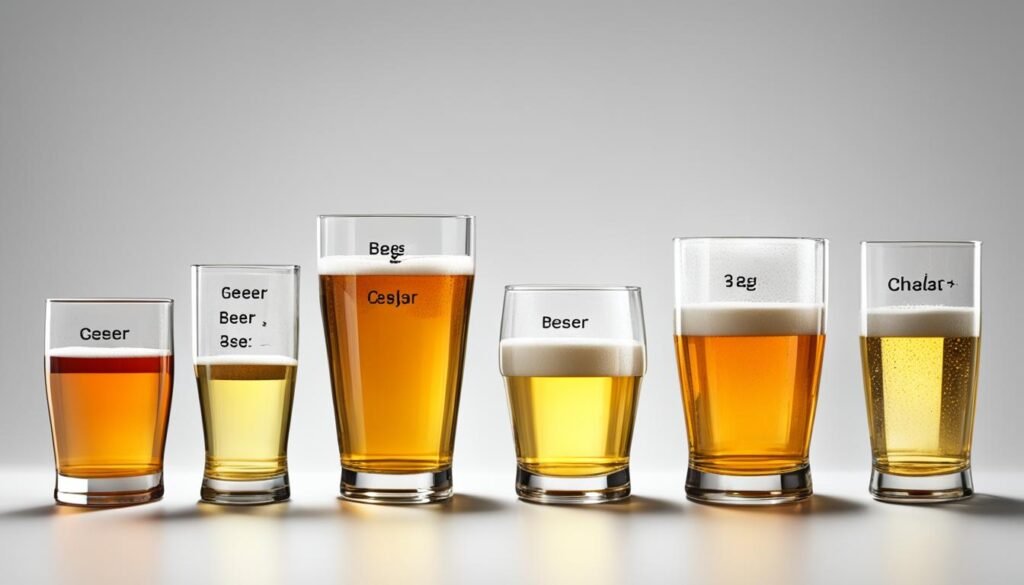In our journey as South African brewers, it’s key to understand the alcohol content in beer. This knowledge helps us make quality brews and promote responsible drinking. The Alcohol by Volume (ABV) tells us the alcoholic percentage in beer. It’s vital for shaping the taste and how easy it is to drink.
Learning about the fermentation process and different beer styles helps us make better products. We can focus on making drinks that are safe for our customers. We’ll also look at market trends and how to drink responsibly. This includes knowing how much to drink and being mindful of our health.
Key Takeaways
- Understanding ABV is critical for our brewing process and ensuring quality.
- A standard drink measures 0.6 ounces of pure alcohol.
- Beer typically ranges from 3.0% to 13.0% ABV, with most beers between 4.0% and 7.0% ABV.
- Light and craft beers can have notably different brewer’s beer alcohol levels.
- Responsible drinking is crucial to mitigate health risks associated with high ABV beers.
The Basics of Alcohol Content in Beer
It’s key to know about alcohol in beer for both makers and drinkers. The Alcohol by Volume (ABV) shows how much pure alcohol is in a drink. Beers have a wide range of ABV, telling us about their strength.
Definition of Alcohol by Volume (ABV)
ABV is vital for knowing the strength of beers. A standard drink of regular beer has about 5% ABV in a 12-ounce serving. This means there’s 5 millilitres of pure alcohol in every 100 millilitres of beer. Wine and malt liquor have different ABV levels too. A 5-ounce wine glass has around 12% ABV, while malt liquor can be from 6% to 8%. Knowing these levels helps us choose what to drink.
Importance of Knowing Alcohol Levels
Knowing alcohol levels helps us control how much we drink. Light beers usually have an ABV of 2% to 4%. Regular beers are around 4% to 6%. Craft beers can be stronger, with an ABV of 6% to 10% or more. These differences change our drinking experience and how safe we are.
| Type of Alcoholic Beverage | Typical ABV Range |
|---|---|
| Light Beers | 2% – 4% |
| Regular Beers | 4% – 6% |
| Malt Liquors | 6% – 8% |
| Craft Beers | 6% – 10%+ |
| Wines | 12% – 20% |
| Hard Liquor | 35% – 60%+ |
The Fermentation Process and Its Role in ABV
In the brewing world, the Fermentation Process is key to making alcohol. It’s vital for setting the Alcohol Content in Beer. Yeast eats sugars from grains, making alcohol and carbon dioxide. This process deeply affects the ABV, making it crucial for brewers to grasp the details.
How Yeast Converts Sugars to Alcohol
Yeast is the star of fermentation. It eats sugars like maltose and turns them into alcohol. A wort with a gravity of 1.040 has about 70%–75% sugars ready for fermentation. The fermentation process works best with the right amount of oxygen, around 6 ppm at 20°C.
The Impact of Fermentation Time on Beer Strength
Fermentation time affects beer’s strength. Lower ABV beers ferment fast, in days. But, higher ABV beers might take weeks or months, gaining complex flavours. Yeast type and amount matter too, with some strains lasting up to 10 generations.
Craft brewers often try longer fermentations for stronger beers. This shows in some new beer styles.
Knowing these details is key to brewing well. By controlling fermentation, we can set the alcohol level and improve the beer’s taste. This knowledge helps us make beers that suit different tastes.
Different Types of Beers and Their Alcohol Content
Exploring the world of beer is key for brewers and beer lovers. Beers have different alcohol levels, which affect their taste and what people like. Knowing about these types helps us make beers for all tastes and events.
Light Beers vs Regular Beers
Light beers are perfect for those who want a refreshing drink with less alcohol. They usually have an alcohol content between 2.3% and 4.2%. Regular beers, on the other hand, have about 4.5% to 6% alcohol.
For example, Bud Light and Guinness are light beers with 4.2% ABV. Regular beers aim for a balanced taste without being too strong.
Craft Beers and Their ABV Range
Craft beers offer a wide range of tastes and strengths. They usually have around 5.9% alcohol, but some can be much stronger. Lagers can be from 6.3% to 9.5% ABV, while stouts can be as low as 3.2% or as high as 12%.
Craft breweries love to try new things, making beers like Tactical Nuclear Penguin with 32% ABV and Snake Venom at 67.5% ABV.
Examples of High-Strength Beers
High-strength beers offer strong flavours and more alcohol. Beers like double IPAs or imperial stouts are over 7% ABV. Brands like Bud Light Platinum and Dogfish Head 60 Minute IPA have about 6% ABV.
Others, like Flying Dog Road Dog, go even higher, showing the wide range in craft beer. Knowing about different beers and their alcohol helps us meet our customers’ tastes.
Understanding Alcohol Content in Beer
Knowing how much alcohol is in beer is key to drinking responsibly. We use Standard Drink Measurements to keep track of what we drink. A standard drink has about 14 grams of pure alcohol. This helps us understand how much we’re drinking when we enjoy our favourite drinks.
Standard Drink Measurements and Their Relevance
A standard drink of beer is usually a 12-ounce serving with about 5% alcohol by volume (ABV). Light beers, with an ABV between 4% and 5%, count as one standard drink. Regular beers, with an ABV of 5% to 6%, can easily go over this limit if not watched. Craft beers can be stronger, with ABVs between 6% and 10%, and some styles even over 15%.
Knowing about Standard Drink Measurements is crucial when drinking stronger beers. Many don’t know that these stronger beers can make you go over the recommended one drink limit quickly. Keeping an eye on how much you drink helps you stay safe.
Drinking too much over time can cause serious health problems, like chronic liver issues and heart disease risks. For more info on the health risks of drinking, check out the article here on how to set your own drinking limits.

The Influence of Ingredients on Beer Strength
The alcohol in beer comes from its Ingredients of Beer. Knowing how these ingredients work together helps us make beers that people like and are healthy. Malted grains, yeast, hops, and water are key in setting the beer’s alcohol level.
The Role of Malted Grains in Determining ABV
Malted grains give the sugars needed for fermentation. This is key in making the alcohol in beer. Lighter malts make a beer with a gentle taste and less alcohol. Darker malts add richer flavours and more alcohol. The drying of these malts also changes the beer’s colour, making it look good with its taste.
How Hops Affect Beer Alcohol Content
Hops add flavour, bitterness, and smell to beer. They also change how fermentation works, which affects the alcohol level. Each type of hop brings its own unique taste and smell. This lets us make different beer styles.
We can change the strength and taste of our beers by balancing malt, hops, and yeast. This way, we can make many types of beer. For more on how ingredients affect beer strength, check out this link.
Health Considerations Related to High Alcohol Beers
Exploring high alcohol content beers shows us the importance of drinking responsibly. It’s key to know our limits to avoid the risks of high ABV. Enjoying strong ales and stouts should always be balanced with awareness and moderation.
Responsible Drinking and Its Importance
Responsible drinking is more than just counting our drinks. Drinking high-strength beers can quickly lead to intoxication, raising health risks. Studies show that drinking more than half an ounce (15 ml) of alcohol daily can cause fatty liver in most people.
Alcohol abuse also leads to serious issues like cirrhosis and damage to vital organs. It’s vital to be aware of these dangers.
Potential Health Risks of High ABV Consumption
Drinking too much alcohol has long-term health risks. These include liver disease, digestive problems, and a weakened immune system. High alcohol intake is linked to cancers of the mouth, throat, and liver.
Drinking three or more drinks a day can also increase the risk of hypertension and heart disease. With this knowledge, we can drink our beers responsibly and protect our health.
